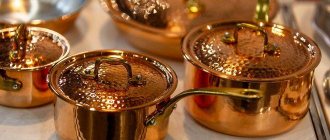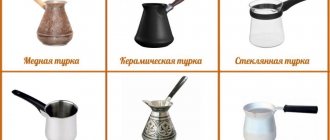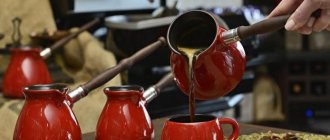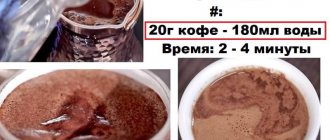General principles of operation of induction cookers
Induction hobs are a perfectly smooth surface made of glass ceramics or other composite material that does not have magnetic or electrical properties. When an induction cooker operates, a magnetic field is created, which leads to heating of the cookware. The most important feature of this type of cooker is the heating principle, which generates a magnetic field.
For these purposes, special coils are used, made of metals with good electrical conductivity. As the oscillation frequency increases, which can vary from 20 to 100 kHz, the electromagnetic field rises above the surface of the hob. If there are materials with magnetic properties on the burner at this time, the process of exciting an electric current occurs.
As current flows, the metal from which the cookware is made resists the movement of electrons, which leads to an increase in temperature. Thus, the stove always remains cold, and an increase in temperature is observed only in cookware that should have ferromagnetic properties.
The process of electromagnetic induction was discovered by Michael Faraday in 1831. The use of this physical phenomenon in the creation of slabs made it possible to obtain products with increased efficiency, reduced energy consumption, and safety. Inside the burner there is a coil made of metal that has magnetic properties. The main disadvantage of this technology is its high price compared to traditional options. It is also very important when using induction to use the correct cookware to achieve the desired temperature rise.
Criteria for choosing cezves for induction
To select special cezves for induction surfaces, you need to focus on:
- Material
- Diameter and dimensions
- Manufacturers.
Products with ferromagnetic properties are specially developed for induction cookers. Not all metal utensils are suitable for them. They must be conductive.
For example, copper, silver, aluminum, glass and ceramic cezve will not brew coffee using induction.
In order to use such devices, a ferromagnetic bottom is attached to them. The bottom composition is made of alloys with magnetic properties. Or, for regular cezves, use a special adapter.
The adaptability of the cezve is checked using a magnet. If the bottom of the Turk attracts it, then it is suitable for an induction cooker.
Enameled steel and cast iron cezves are considered an excellent option. However, a solid steel pot often has a non-stick coating. Or it is made of stainless steel. Such types do not improve the taste of the drink; moreover, the steel material does not allow the formation of a narrow neck - the correct shape of cezves. The large throat also does not create the correct foam. It would prevent the loss of taste and aroma that essential oils create. In addition, steel turks are much more susceptible to coffee runaway. A cezve made of copper and ceramics with a ferromagnetic bottom is considered the best solution for a compromise.
Another requirement is special sizes. A pot for an induction cooker must have a bottom area of at least 70% of the size of the burner. Otherwise, the hob will not “recognize” the presence of the Turk and will not work. Acceptable dimensions of the Turk's circumference should be in the range of 8 - 12 cm. The best thickness of the bottom of the cezve should be more than 2 mm.
When choosing a Turk, you need to study the instructions for the stove. The manufacturer specifies the smallest permissible diameter for each slab. In most cases, you will need to purchase a cezve with a bottom size starting from 8 cm.
Induction heating is not entirely liked by those who strictly follow the classic, almost ritualistic traditions of making coffee.
Volume
The volume of the cezve should be from 150 to 500 ml. Brewing an invigorating drink follows the principle “less is more.” However, the burner may not “feel” a very small volume of cezve due to the unsuitable diameter of the bottom. Therefore, if you do not plan to use an adapter, do not rush to choose an overly miniature model.
A 350 ml Turkish coffee pot is suitable for brewing two servings of coffee, and a 750 ml one for the office.
Pen
Convenience, safety and thermal insulation are the main requirements for cezve handles. You should choose long handles, attached to the Turk at a certain angle and comfortable in the hand.
What cookware is suitable for an induction cooker?
When choosing an induction panel, you need to pay special attention to the cookware, since not every household item can be used for cooking. It is often necessary to completely reconsider existing items. This also applies to coffee turks for an induction cooker, which has general requirements. The main feature of induction is that only the metal area is heated, while the rest of the burner remains cold. The most important quality that cookware should have is the presence of ferromagnetic properties at the bottom. Simply put, it is necessary that the selected item of utensil can conduct electromagnetic waves and be subjected to magnetic induction for subsequent heating. Many manufacturers produce special cookware that has a number of distinctive features:
- the presence of a disk in the center, the purpose of which is the accumulation and distribution of thermal energy;
- endowing the bottom with ferromagnetic properties;
- a perfectly smooth bottom, with a metal thickness of at least 2 mm.
It is important that the bottom of the cezve covers a sufficient area of the cooking surface for its operation. It is also important to comply with one more requirement - the diameter of the bottom of the pot for a glass-ceramic stove must be at least 30% of the burner area. Otherwise, the latter simply will not turn on.
To determine whether the selected cookware is suitable for panels using induction technology, you can pay attention to the presence of a special sign in the form of an elongated upward spiral and the inscription “induction”.
Ceramic coffee pot: features and benefits
There is a special category of coffee lovers - they prepare this drink exclusively in Turk. They do not recognize any newfangled devices, and cutting-edge recipes only make them smile condescendingly. They nod sympathetically to the adherents of coffee machines and siphons and continue to closely monitor that their coffee does not escape from the Turks.
Indeed, you can fully reveal the taste and aroma of coffee, and extract its most hidden notes, only by preparing coffee by hand. Therefore, if you are tired of being content with a pale copy of real coffee, which should be “black as the devil and hot as fire,” be sure to buy a Turk.
Traditionally, the Turku is made of copper. The ceramic pot is a new product that has already become popular among professionals and ordinary lovers of good coffee. Let us also get to know this skillful beauty better.
Ceramic coffee pot: features and benefits
First, it’s worth understanding the terms. Ceramic Turks should not be confused with clay ones, although it would seem - what is ceramics made of if not clay? Why are products made from the same materials called differently?
Clay Turk
- The clay Turk is fired, but not glazed.
- Clay Turk is porous, so it perfectly absorbs odors and coffee oils. This feature is highly valued by some experts. With each use, the container is saturated with the aromas of previous drinks, which mix with the fresh one, enriching it. It is believed that the value of such a Turka increases with each subsequent use.
- But for these reasons, it is recommended to cook only one type of coffee in a clay pot.
Ceramic Turk
- The ceramic Turk is not only fired in a kiln at high temperature, but also undergoes final processing - a glassy coating is applied to it - glaze.
- This coating is what makes the ceramic Turk so convenient and practical to use. Ceramics does not oxidize, does not absorb odors, tastes, and does not enter into chemical reactions.
Therefore, if your goal is to enjoy the pure taste of a particular type of coffee, without any impurities, then a ceramic coffee pot will be your best assistant. With its help, you can experiment with different types of coffee, find interesting combinations, creating your own signature blends.
A ceramic pot will invariably provide high taste characteristics of the finished drink. A wide bottom will evenly distribute heat throughout the entire volume of the vessel, thick walls will maintain temperature, and the difference between a wide bottom and a narrow neck will preserve all the aromatic substances in the future drink.
Features of ceramic Turks
When preparing coffee in a ceramic pot, do not forget that ceramics have low thermal conductivity. This means that the vessel will heat up slowly, but it will also cool down just as slowly. You may need to practice to get the hang of removing the Turk from the heat exactly at the moment when the head of foam is just about to begin to rise. If you remove it from the heat in the middle of the process, the coffee will continue to rise and may run off onto the stove.
The ceramic Turk must be removed from the heat before the foam rises to the edge of the Turk. Ceramics retains temperature for a long time and heats the liquid for some time after the contact with the heat source ceases.
Ceramic Turks can be made industrially or manually. The factory Turk will have a guarantee, so you can be confident in the quality of the product. Well, a handmade item is unique in its kind and will have an elusive charm and positive energy, for which such products are valued.
Which Turk is better, copper or ceramic?
Traditionally, the cezve was made of copper, so all its successors – aluminum, brass, clay and ceramic – are compared with this authentic cezve. The answer will be indecently simple - it all depends on your personal preferences. Each option has its own advantages and disadvantages, which depend on the physical characteristics of the material.
Copper Turk
- Copper has a high thermal conductivity coefficient, due to which it heats up quickly and cools down just as quickly. It was this property that was decisive initially, because it made it possible to prepare coffee directly on hot sand. Copper stops heating immediately after contact with the heat source ceases.
- A copper Turk must have a complete internal coating, usually from food-grade tin, because copper forms soluble compounds that are dangerous to human health.
- Copper Turks are much cheaper than ceramic ones.
Ceramic Turk
- Ceramics have a low thermal conductivity coefficient. It cools down as slowly as it heats up. The ceramic Turk continues to heat the drink even after the vessel is removed from the heat. If you miss the right moment, the coffee may run away and instead of enjoying the noble drink, you will have to wash the stove and table from this drink.
- Ceramic Turks do not absorb the smells and tastes of previous servings of coffee. Therefore, the taste of coffee in such a Turk will be pure, without any additional surprises.
- Caring for ceramic cezves will not be difficult for you; they are easy to clean and do not require any special conditions.
- Ceramics is completely inert, which means that it does not enter into any chemical reactions, which means it is completely safe for your health.
- Despite all its advantages, ceramics have a single, but very annoying drawback - it must be handled with extreme care, it breaks easily.
The ceramic Turk is afraid of temperature changes and shocks. You need to handle it carefully and avoid letting it fall on the floor. Don't rinse it with cold water immediately after use; let it cool on the stove or on a counter.
- Having made a choice in favor of a ceramic Turk, you should be prepared to pay on average one and a half times more for it than for a copper Turk of the same volume.
When it comes to design, it is purely a matter of your taste. Both materials, copper and ceramics, provide the opportunity for sophisticated decoration. Copper Turks are decorated with elegant chasing, and ceramic ones are covered with intricate patterns and painted in various colors.
How to use a ceramic Turk on a gas stove?
- The ceramic pot is safe to use on a gas stove. There is no need to worry that the container will crack or burst. The firing temperature used to harden ceramics is much higher than the temperature that a gas stove can provide.
- Make sure that the ceramic pot stands level and stable on the burner. The diameter of the burner should be less than the diameter of the bottom of the Turk.
- If your stove does not have a burner of a suitable diameter, we advise you to use a metal divider. With its help, you will securely install the Turk and ensure even heating.
- In addition, such a cutter will help preserve the original appearance of the Turk, because high flames can smoke the sides of the cezve.
Coffee should be prepared in a ceramic Turk over the lowest heat. This ensures even heating of the dishes.
Features of using ceramic Turks
What other subtleties should you know before buying a ceramic cezve?
Using a ceramic Turk on different slabs
- If you have an induction cooker, you will need a special adapter for induction cookers. It is a metal disk with an internal magnetic layer that provides uniform heating and works with any cookware that is not intended for induction cookers, including ceramic and glass.
- Glass-ceramic hobs do not impose any requirements. You just put the Turk on the stove and make coffee.
- If the burners on your electric stove have a spiral shape, use a divider that will ensure uniform heating. If the burners are made in the form of solid metal disks, you will not need any additional devices.
Remember, when using a ceramic Turk, you should first install it on the stove, and only then turn on the heat.
Caring for a ceramic pot
- Caring for ceramics is very simple and does not require any special effort from you. After use, let the Turk cool, then wash it with warm water and a mild detergent and dry it.
- Do not use abrasive detergents or products containing active acids.
- Dishwasher safeness depends on manufacturer's recommendations.
- It is strictly forbidden to rinse a hot pot with cold water. Ceramics are afraid of sudden temperature changes. After use, allow the cezve to cool on the stove or on a dry kitchen rack.
How to choose a ceramic Turk
What should you pay attention to when buying a new cezve? What nuances should be taken into account?
The range of ceramic Turks is quite wide, you can easily find one that suits your liking. They are sold in specialized tea and coffee shops, regular supermarkets and online stores.
- A ceramic pot should be conical in shape, with a wide bottom and a narrow neck. This shape ensures that the grounds settle quickly. A wide bottom is necessary for slow and even heating.
- The narrow neck ensures the formation of a kind of plug of rising foam. This stopper “seals” the coffee, keeping all the aromas and oils in it.
- If you are buying a Turk for the first time, take one with a funnel-shaped top. With it, you will have a few seconds head start to save your drink - after all, the foam in it rises a little slower.
- Pay attention to the handle of the ceramic Turk. Firstly, it should be comfortable, not slip in your hand, not scroll and not heat up. Secondly, take a closer look at the place where the handle is attached to the Turk itself; this is the weak point in all Turks, regardless of the material of manufacture.
- As for the size of the Turk, choose a container exactly for the number of cups you are preparing at a time. Remember the rule - the smaller the Turk, the tastier the coffee.
The volume of the Turks is usually indicated at the bottom. The best choice is for one to three cups of coffee. If you have a large group of people, don’t be lazy to brew coffee two or even three times in a small pot. The drink will be much tastier.
Reviews about ceramic Turks
It is no secret that a theory takes on a convincing form only when it is supported by practical evidence. Below you will find several confessions from several of our customers, owners of ceramic Turks - novice coffee lovers and already quite confident users. We asked them to share their impressions after the purchase.
Let's see if they liked the ceramic cezve.
Oleg, has been using a ceramic Turk for 1.5 months
— I’ll say right away that this is not my first Turk. I brought the first one from Turkey. Copper, forged, excellent little thing. I made coffee only in it, got used to it like a real barista. I really liked it myself, and my friends also really liked my coffee. After several years of use, I noticed that the inner coating was cracked. I read that it can be harmful to health. Now it sits in the closet and decorates the kitchen. The next one was clay, but something didn’t work out with it.
And this beauty and I have had complete mutual understanding since the first coffee we brewed together. I don’t treat it particularly carefully, no. Well, unless I throw it on the floor in a big way, yes.
Maryana, has been using a ceramic Turk for 3 months
“I, like all impressionable women, chose a Turk based on her appearance. And let me tell you, it's something. I am happy every morning when I put it on the stove. Unfortunately, the first use had to be postponed because I did not think about the fact that my induction cooker would require an adapter. I had to order that too. But every cloud has a silver lining; with the adapter, my favorite ceramic saucepan, which had been idle, and my hand didn’t raise to throw it away, came back into use.
Alina, has been using a ceramic Turk for 2 weeks
— I am a long-time coffee lover, I also have a lot of Turks. But this one, I feel, will become one of my favorites. My husband is a conservative and has been drinking the same variety for many years. And I’m an experimenter, and I mix varieties and add spices to suit my mood. And try it, it's very entertaining! I don't like cinnamon, but I love cardamom. In the cold season I add a pinch of cayenne pepper, it’s something!
For me, coffee in a ceramic pot is special. Somehow homely and very soulful.
Vitaly, has been using a ceramic Turk for 2 months
— I bought it as a gift for a friend, he is a collector. And he hit the bull’s eye, saying that he himself had been eyeing a similar one for a long time. We tried it right away, and I immediately, without leaving the couch, ordered one for myself from the same online store!
- What do you like? What delicious coffee and no hassle. Prepared, drink. While drinking, the Turk has cooled down, you can rinse it. I also use detergent once or twice. What is there to wash?
Andrey Alexandrovich, has been using a ceramic Turk for 6 months
— My wife and I fell in love with Turkish coffee after a trip to Istanbul. For us, making coffee is a real ritual. First, I grind the coffee – I bought a special grinder while traveling, then I prepare it. With the copper Turk I was somehow uneasy all the time. I am a slightly suspicious person, I checked everything for cracks, waited for harmful substances to begin to be released. That’s why we now use copper for decoration, but a ceramic pot is safe and it’s safer to use it.
The coffee always turns out good. Well, maybe the first few times you need to get used to it, sometimes you run away. And now - no problem. I can’t do it with my eyes closed, of course, but with my left eye – easily!
All clients mentioned the ease of use and ease of maintenance of the ceramic Turk. They also noted the excellent taste of coffee prepared in a ceramic pot.
When used carefully, a ceramic pot will give you many cups of great coffee. Enjoy every sip, savor every moment.
Dimensions and materials of induction Turks
To buy the right coffee pot for your induction cooker, you should take into account what it is made of. You can immediately note the materials that are not used in the manufacture of real cezves intended for this type of panel. Coffee connoisseurs consider ceramics or clay to be the best material for Turkish coffee, since it has the unique properties of preserving the aroma. These include copper, aluminum and ceramics. In their pure form, these materials do not have magnetic properties. Cezves can be used in this case only if they have a special bottom endowed with ferromagnetic properties.
Steel is considered the optimal Turkish material for an electric induction cooker. But true connoisseurs believe that clay is the ideal material for the item needed to make coffee. It is this that is capable of preserving the aroma due to its porous structure.
FOR YOUR INFORMATION ! You can use clay cezves, but it is very important that the bottom has a special magnetic insert to ensure the required heating. For induction panels, the stainless steel option is most often purchased. The second important selection criterion is the size of the cezve. The most important thing is to ensure the correct diameter. It must be no less than 30% of the total diameter of the burner, otherwise it simply will not turn on.
Coffee connoisseurs also pay attention to the volume of the cezve. Usually on store shelves you can find options that offer to brew from 0.15 to 0.5 liters of drink. In the brewing process, the principle “less is better” applies.
That is why it is recommended to choose not the largest models. But at the same time, the smallest options do not satisfy the requirement of covering the burner area to activate the magnetic field, so they will not heat up.
IMPORTANT!
One of the selection criteria is the handle, which should be long enough, fit comfortably in the hand and not heat up during the cooking process. The handle should be long and not hot so as not to burn your hands
What to consider when choosing a cezve for an induction cooker
Not all metal cookware is suitable for an induction hob. The coffee pot is no exception. There are specially designed models, the bottom of which is made of ferromagnetic material, as indicated by the “induction” sign on their surface.
Material of manufacture
When choosing a Turk, you don’t have to buy expensive special dishes. It is enough to take a simple magnet with you to the store and choose the one whose bottom will strongly attract it.
Copper ceramic and aluminum models will not work. The best option may be a steel Turk.
Dimensions
Even if you choose products from the right material, the result will not necessarily be positive, since the size of the dishes and its bottom is of great importance.
The size of the bottom of the Turk must be greater than 30% of the diameter of the burner, otherwise the stove simply will not turn on. Therefore, before you go to the store for a new purchase, you should first measure the diameters of the burners and, based on the data obtained, look for suitable cookware.
The volume of the Turks can be arbitrary. The main thing is that the bottom diameter is 8-12 cm. However, these requirements are not important if you plan to use an adapter disk.
Handle type
The handles of the cezve should first of all be comfortable to use, fit organically in the palm of your hand, and be located at a slight angle relative to the horizontal surface.
Advice! It is better to choose a handle material that does not heat up (plastic, rubber, wood). To ensure greater safety, the handle should be extended.
Adapter for induction cooker - buy to brew coffee in any Turk
If you really want to enjoy the true aroma of the finished drink and use a clay or copper cezve, there is the possibility of purchasing a special device called an adapter. Using an induction disc or adapter will make it possible to use any material. This is a simple metal disc that is placed on the burner. The stove considers it an example of “correct” cookware, which leads to heating. The adapter can be used to place utensils made of any material, in particular cezves made of ceramic or copper.
When using an induction disc, the diameter of the bottom does not matter. When purchasing an adapter, it is very important to choose models that have ferromagnetic properties. Poor-quality products can cause premature wear of the stove, and will also not allow you to prepare tasty and aromatic coffee. The presence of a handle on the adapter increases the comfort of its use. Induction discs consist of several metal plates, between which there is a magnetic layer, due to which it is possible to achieve uniform heating of the cookware.
It would be optimal to purchase a disk with a handle, which will simplify the process of use. The handles are made of materials that do not heat up, which makes it possible to operate without tacks.
FOR YOUR INFORMATION ! If the adapter is purchased exclusively for a coffee turk for an induction cooker, it is better to buy a small model so as not to clutter up the kitchen space with unnecessary accessories.
The nuances of making coffee on an induction surface
A special feature of this technique is induction heating not of the surface of the stove itself, but of the contents. This has its pros and cons. If we talk about coffee, heating occurs at lightning speed, which will adversely affect the quality of the natural invigorating drink, because it requires gradual heating. Therefore, you should be prepared for the fact that the dishes will need to be periodically lifted above the working surface of the burner: only such actions will help ensure uniform and gradual heating of the product.
You can also control the heating of coffee using special adapters for such modern devices with pulse operation. In this case, the disc itself will be heated, and the coffee inside will gradually warm up.
Which Turk for an induction cooker is best to buy, depending on the manufacturer
When choosing a specific model, you need to take into account the manufacturer, since there are models from several companies on the market. They all have their positive and negative sides. Gipfel company presents the widest range of products
Turks for induction cooker Gipfel, Korkmaz, Erringen
In fact, among the main brands producing special Turks for induction devices, 4 manufacturers predominate. It is their products that are considered the best and are popular among gourmets:
- Gipfel . A brand that produces a wide range of Turks for brewing coffee on induction panels. The model range is represented by the largest variety of volumes - 390, 500 and 700 ml. All cezves of this brand are made of polished steel, have a wide neck and a fairly thick bottom (from 6 to 8 mm).
- Korkmaz . This manufacturer specializes in producing Turkish sets of different volumes. Just one set includes three pieces, the smallest of which has a capacity of only 20 ml, and the largest - 400 ml. One of the features is the presence of a comfortable handle with silicone inserts.
- Erringen . A company that also produces stainless steel cezves. The company does not offer the widest range of models. It includes 360 and 720 ml models. Among the distinctive features, comfortable handles should be noted.
Under the Tima brand, copper cezves with a narrow neck are produced to obtain a rich taste
Copper cezves Tima
The Tima brand stands out, as it is the only manufacturer on the Turkish market that produces copper cezves. Their bottom is endowed with ferromagnetic properties specifically for heating.
And the copper alloy ensures fast and uniform heating, which is very important when preparing an invigorating drink. Another advantage of copper products is the presence of a narrow neck, which ensures a rich taste.
FOR YOUR INFORMATION ! Copper has thermal conductivity 10 times better than steel and 2 times better than aluminum.
We use an induction adapter
Let's assume that you are a true coffee lover and think that a coffee pot should be made of copper or clay. Clay is ideal for brewing one type of coffee.
Its porous structure perfectly absorbs coffee essential oils and releases them to subsequent portions. At the same time, the coffee turns out tastier and tastier each time.
Copper has excellent thermal conductivity. The coffee in such a pot heats up evenly, and its durable structure allows you to experiment with different types of coffee.
You don’t have to give up your usual methods of brewing coffee. To do this, you will need an induction adapter, which is shaped like a metal plate with a diameter of 20 - 22 centimeters. The surface immediately identifies it as an induction Turk and begins to heat up. On such a surface you can place dishes of any size and material (preferably heat-resistant).
Don't skimp on induction discs. Buy only ferromagnetic ones. If you buy a cheap steel one, it will cause overheating of the induction surface and it will begin to collapse.
Branded adapters consist of subsequent layers of steel and ferromagnet. This allows for uniform heating of the disk.
Prices for adapters are quite high and start from 3,000 rubles for branded options. If you don’t want to pay that amount and prepare coffee on the induction surface in your favorite Turk, you can use a frying pan. Fill it with sand and pebbles and brew Turkish coffee.
Today, many people argue which is better: a geyser coffee maker or a Turkish coffee maker. We tried to objectively understand the issue and highlight the advantages and disadvantages of these items.
If you decide to buy a Turk and don’t know which one is better: clay or ceramic, copper or aluminum, then this is the place for you.
How to brew coffee in an induction pot
To prepare the perfect drink, you need to follow the brewing technology. In normal mode, the induction cooker operates at low power (ranging from 45 to 50%). In this case, heating is carried out in pulse mode, which is completely unsuitable for coffee, which requires a uniform temperature with a gradual increase. That is why to prepare a drink on an induction panel you need to set the power in the range from 70 to 80%. After foam has formed, be sure to remove the cezve from the stove. A small amount of ground coffee is poured into the Turk. Usually 30-40 grams is enough. Next, add a pinch of salt and sugar (optional). The powder is poured with cold water and gradually brought to a boil.
When foam appears, the cezve should be removed from the stove, allowed to settle and placed back on the burner. Ideally, repeat this procedure 5 times to fully develop the aroma and taste. After completion, it is recommended to let the finished mixture stand for a few seconds to completely saturate the drink with aroma, after which the coffee can be drunk.
FOR YOUR INFORMATION ! You should not leave the finished coffee for a long time, otherwise the oils may simply erode and the aroma will be lost.
Upon completion of brewing, it is advisable to pour the coffee into cups to prevent the oils from evaporating. If you have an induction cooker, you can indulge in freshly brewed coffee. In order to be able to enjoy the drink, you should purchase special dishes or simply buy an adapter. Once again, you can learn the intricacies of choosing a Turk for induction from the presented video.
Ingredients for properly preparing delicious coffee
To prepare the classic version in a Turk with a standard volume of 200-250 ml, you will need 3-3.5 tsp. ground raw materials. It is advisable to take coffee in ground form and the finest grind - this will allow you to get a thick and strong foam. In addition, the grains are finely ground, almost “to dust”, have a short extraction time, and a tasty drink will be prepared in a matter of minutes.
To make Turkish coffee, you need to use ground coffee.
Also prepare 150-180 ml of clean filtered water. The water should not be boiled, otherwise the taste will deteriorate greatly. Hard tap water is also not suitable. To cook in a Turk, you need to take bottled water or from a filter. Well, add salt, sugar, spices to taste.











